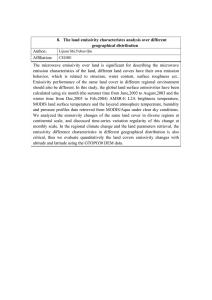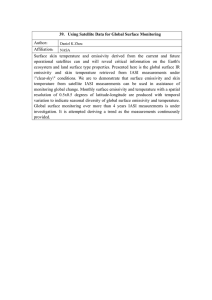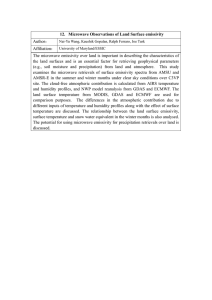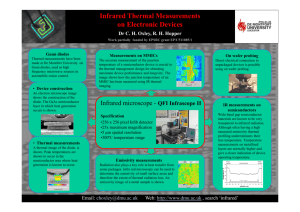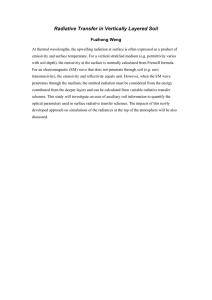High-temperature stability and selective thermal emission
advertisement
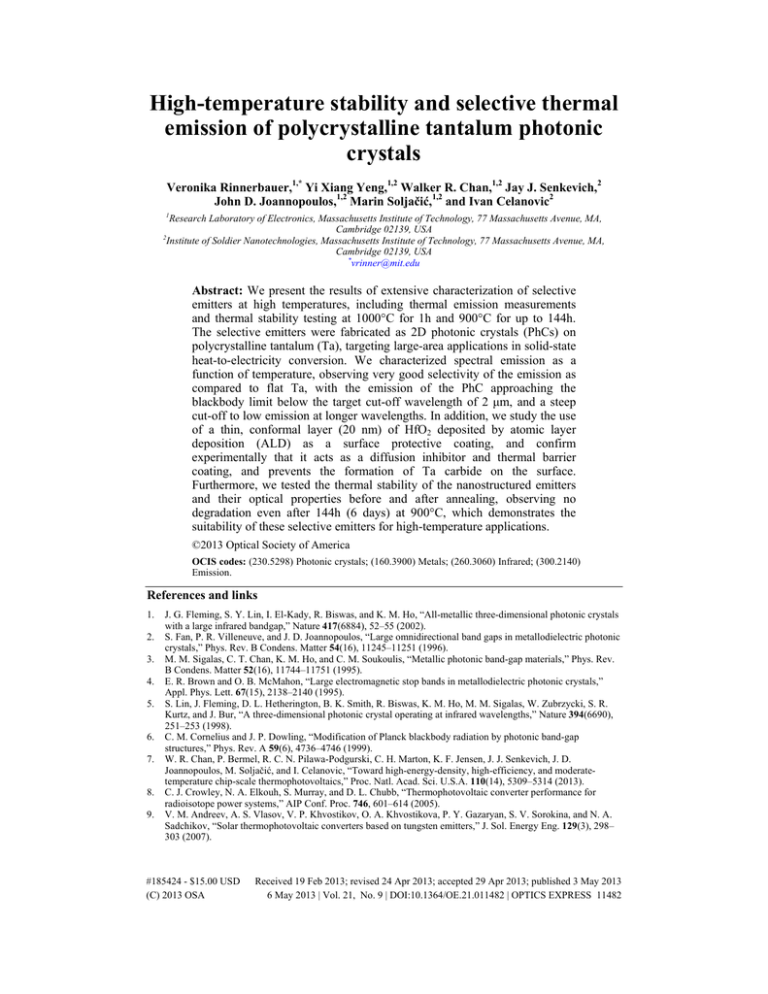
High-temperature stability and selective thermal emission of polycrystalline tantalum photonic crystals Veronika Rinnerbauer,1,* Yi Xiang Yeng,1,2 Walker R. Chan,1,2 Jay J. Senkevich,2 John D. Joannopoulos,1,2 Marin Soljačić,1,2 and Ivan Celanovic2 1 2 Research Laboratory of Electronics, Massachusetts Institute of Technology, 77 Massachusetts Avenue, MA, Cambridge 02139, USA Institute of Soldier Nanotechnologies, Massachusetts Institute of Technology, 77 Massachusetts Avenue, MA, Cambridge 02139, USA * vrinner@mit.edu Abstract: We present the results of extensive characterization of selective emitters at high temperatures, including thermal emission measurements and thermal stability testing at 1000°C for 1h and 900°C for up to 144h. The selective emitters were fabricated as 2D photonic crystals (PhCs) on polycrystalline tantalum (Ta), targeting large-area applications in solid-state heat-to-electricity conversion. We characterized spectral emission as a function of temperature, observing very good selectivity of the emission as compared to flat Ta, with the emission of the PhC approaching the blackbody limit below the target cut-off wavelength of 2 μm, and a steep cut-off to low emission at longer wavelengths. In addition, we study the use of a thin, conformal layer (20 nm) of HfO2 deposited by atomic layer deposition (ALD) as a surface protective coating, and confirm experimentally that it acts as a diffusion inhibitor and thermal barrier coating, and prevents the formation of Ta carbide on the surface. Furthermore, we tested the thermal stability of the nanostructured emitters and their optical properties before and after annealing, observing no degradation even after 144h (6 days) at 900°C, which demonstrates the suitability of these selective emitters for high-temperature applications. ©2013 Optical Society of America OCIS codes: (230.5298) Photonic crystals; (160.3900) Metals; (260.3060) Infrared; (300.2140) Emission. References and links 1. 2. 3. 4. 5. 6. 7. 8. 9. J. G. Fleming, S. Y. Lin, I. El-Kady, R. Biswas, and K. M. Ho, “All-metallic three-dimensional photonic crystals with a large infrared bandgap,” Nature 417(6884), 52–55 (2002). S. Fan, P. R. Villeneuve, and J. D. Joannopoulos, “Large omnidirectional band gaps in metallodielectric photonic crystals,” Phys. Rev. B Condens. Matter 54(16), 11245–11251 (1996). M. M. Sigalas, C. T. Chan, K. M. Ho, and C. M. Soukoulis, “Metallic photonic band-gap materials,” Phys. Rev. B Condens. Matter 52(16), 11744–11751 (1995). E. R. Brown and O. B. McMahon, “Large electromagnetic stop bands in metallodielectric photonic crystals,” Appl. Phys. Lett. 67(15), 2138–2140 (1995). S. Lin, J. Fleming, D. L. Hetherington, B. K. Smith, R. Biswas, K. M. Ho, M. M. Sigalas, W. Zubrzycki, S. R. Kurtz, and J. Bur, “A three-dimensional photonic crystal operating at infrared wavelengths,” Nature 394(6690), 251–253 (1998). C. M. Cornelius and J. P. Dowling, “Modification of Planck blackbody radiation by photonic band-gap structures,” Phys. Rev. A 59(6), 4736–4746 (1999). W. R. Chan, P. Bermel, R. C. N. Pilawa-Podgurski, C. H. Marton, K. F. Jensen, J. J. Senkevich, J. D. Joannopoulos, M. Soljačić, and I. Celanovic, “Toward high-energy-density, high-efficiency, and moderatetemperature chip-scale thermophotovoltaics,” Proc. Natl. Acad. Sci. U.S.A. 110(14), 5309–5314 (2013). C. J. Crowley, N. A. Elkouh, S. Murray, and D. L. Chubb, “Thermophotovoltaic converter performance for radioisotope power systems,” AIP Conf. Proc. 746, 601–614 (2005). V. M. Andreev, A. S. Vlasov, V. P. Khvostikov, O. A. Khvostikova, P. Y. Gazaryan, S. V. Sorokina, and N. A. Sadchikov, “Solar thermophotovoltaic converters based on tungsten emitters,” J. Sol. Energy Eng. 129(3), 298– 303 (2007). #185424 - $15.00 USD (C) 2013 OSA Received 19 Feb 2013; revised 24 Apr 2013; accepted 29 Apr 2013; published 3 May 2013 6 May 2013 | Vol. 21, No. 9 | DOI:10.1364/OE.21.011482 | OPTICS EXPRESS 11482 10. A. Steinfeld, “Solar thermochemical production of hydrogen - a review,” Sol. Energy 78(5), 603–615 (2005). 11. A. Heinzel, V. Boerner, A. Gombert, B. Bläsi, V. Wittwer, and J. Luther, “Radiation filters and emitters for the NIR based on periodically structured metal surfaces,” J. Mod. Opt. 47, 2399–2419 (2000). 12. H. Sai and H. Yugami, “Thermophotovoltaic generation with selective radiators based on tungsten surface gratings,” Appl. Phys. Lett. 85(16), 3399–4001 (2004). 13. E. Rephaeli and S. Fan, “Tungsten black absorber for solar light with wide angular operation range,” Appl. Phys. Lett. 92(21), 211107 (2008). 14. I. Celanovic, N. Jovanovic, and J. Kassakian, “Two-dimensional tungsten photonic crystals as selective thermal emitters,” Appl. Phys. Lett. 92(19), 193101 (2008). 15. M. Araghchini, Y. X. Yeng, N. Jovanovic, P. Bermel, L. A. Kolodziejski, M. Soljačić, I. Celanovic, and J. D. Joannopoulos, “Fabrication of two-dimensional tungsten photonic crystals for high-temperature applications,” J. Vac. Sci. Technol. B 29(6), 061402 (2011). 16. V. Rinnerbauer, S. Ndao, Y. Xiang Yeng, J. J. Senkevich, K. F. Jensen, J. D. Joannopoulos, M. Soljačić, I. Celanovic, and R. D. Geil, “Large-area fabrication of high aspect ratio tantalum photonic crystals for hightemperature selective emitters,” J. Vac. Sci. Technol. B 31(1), 011802 (2013). 17. H. Sai, Y. Kanamori, and H. Yugami, “High-temperature resistive surface grating for spectral control of thermal radiation,” Appl. Phys. Lett. 82(11), 1685–1687 (2003). 18. C. Schlemmer, J. Aschaber, V. Boerner, and J. Luther, “Thermal stability of micro-structured selective tungsten emitters,” AIP Conf. Proc. 653, 164–173 (2003). 19. P. Nagpal, D. P. Josephson, N. R. Denny, J. DeWilde, D. J. Norris, and A. Stein, “Fabrication of carbon/refractory metal nanocomposites as thermally stable metallic photonic crystals,” J. Mater. Chem. 21(29), 10836–10843 (2011). 20. K. A. Arpin, M. D. Losego, and P. Braun, “Electrodeposited 3D tungsten photonic crystal with enhanced thermal stability,” Chem. Mater. 23(21), 4783–4788 (2011). 21. M. L. Schattenburg, R. J. Aucoin, and R. C. Fleming, “Optically matched trilevel resist process for nanostructure fabrication,” J. Vac. Sci. Technol. B 13(6), 3007–3011 (1995). 22. M. L. Schattenburg, E. H. Anderson, and H. I. Smith, “X-ray/VUV transmission gratings for astrophysical and laboratory applications,” Phys. Scr. 41(1), 13–20 (1990). 23. A. F. Oskooi, D. Roundy, M. Ibanescu, P. Bermel, J. D. Joannopoulos, and S. G. Johnson, “Meep: A flexible free-software package for electromagnetic simulations by the FDTD method,” Comput. Phys. Commun. 181(3), 687–702 (2010). 24. Y. X. Yeng, M. Ghebrebrhan, P. Bermel, W. R. Chan, J. D. Joannopoulos, M. Soljačić, and I. Celanovic, “Enabling high-temperature nanophotonics for energy applications,” Proc. Natl. Acad. Sci. U.S.A. 109(7), 2280– 2285 (2012). 25. Y. S. Touloukian and D. P. DeWitt, Thermophysical Properties of Matter, Vol. 7: Thermal Radiative Properties (IFI/Plenum, 1970). 1. Introduction Metallic photonic crystals are highly promising as selective thermal emitters and absorbers since they exhibit large optical bandgaps and allow for outstanding control over the photonic density of states [1–6]. Such selective emitters and absorbers are crucial elements in solid state heat-to-electricity energy conversion applications, including thermophotovoltaic (TPV), solar-thermophotovoltaic, solar-thermal and solar-thermochemical systems [7–10]. Considering the targeted high operating temperatures (> 1000 K) and the long operational time span typical for energy conversion applications, stringent challenges regarding material design have to be met, and proper material selection to prevent melting, evaporation, diffusion or chemical reactions is essential. In addition, severe minimization of any material interfaces to prevent thermochemical problems such as delamination and to promote structural stability in the presence of surface diffusion are critical. For thermal stability and high performance at elevated temperatures it is most advantageous to use all-metallic 2D PhCs. In particular, refractory metals are advantageous due to their high melting points (> 3000 K) and low vapor pressure. In addition they exhibit an intrinsic wavelength selective emissivity, exhibiting low emissivity at wavelengths greater than ~2.0 μm. This low emissivity, i.e. high reflectivity, at long wavelengths is vital for selective emitters for energy conversion applications like TPV, since longer wavelength emission is generally below the bandgap of small bandgap TPV cells, and lost as waste heat that is also potentially damaging the TPV cell and reducing its performance. The increased emissivity below ~2.0 μm due to interband transitions on the other hand enables us to easily enhance emission in the wavelength range important for TPV energy conversion. This intrinsic wavelength selectivity is also necessary for application as an efficient (solar) selective absorber characterized by strong (solar) absorption and low thermal emissivity. We can easily design the emissivity of #185424 - $15.00 USD (C) 2013 OSA Received 19 Feb 2013; revised 24 Apr 2013; accepted 29 Apr 2013; published 3 May 2013 6 May 2013 | Vol. 21, No. 9 | DOI:10.1364/OE.21.011482 | OPTICS EXPRESS 11483 the PhC emitter or absorber by adjusting the parameters of the PhC, e.g. to match the high emissivity band and its cut-off wavelength to the bandgap of a PV cell. In the past, studies on W PhCs have demonstrated highly promising results regarding selective emitters and absorbers [11–15]. In our recent approach we have investigated selective emitters based on tantalum (Ta), whose inherent material properties, such as its machinability and weldability, enable integration of these devices into complex systems like high-temperature solid state energy conversion schemes, bringing this highly promising field one step closer to high-efficiency applications. We have established a fabrication route to large area (2 inch, i.e. 5 cm diameter), 2D PhCs with high aspect ratio (> 8:1), i.e. ratio of depth of the cylindrical cavities to their diameter, based on standard microfabrication processes [16]. As substrates, we use polycrystalline Ta, as the cost and availability of single-crystal substrates are prohibitive for large-area (> 1cm2) applications. The fabricated 2D Ta PhCs show a high level of spectral selectivity, enhancement of the emissivity at wavelengths below cut-off wavelength approaching that of blackbody, and steep cut-off between high and low emissivity spectral regions. In numerous studies of selective emitters and absorbers, emissivity or absorptivity measured at room temperature are studied and given as a measure of their performance [13– 15]. Although room temperature optical properties are very useful for evaluation and comparison of different emitter strategies, it is essential to characterize emission at the target operating temperatures to be able to realistically evaluate their performance and suitability for high-temperature applications. For the same reason, it is crucial to investigate thermal stability of the emitters and their optical properties over an extended period of time. In this manuscript, we present the results of emission measurements at high temperature, and a route to accurately estimate the sample temperature, which is critical for hightemperature characterization of the optical properties. We characterize the spectral emission of the fabricated PhCs in a vacuum setup under Ar atmosphere at different heater temperatures by Fourier transform infrared spectroscopy (FTIR), calibrating with a blackbody source, and estimating the sample temperature from the expected emissivity as taken from numerical simulations, using high-temperature data for the material properties. The relative uncertainty in the sample temperature deduced with this method is < 0.8% and the emission and the emissivity derived with this sample temperature show excellent agreement with numerical simulations. Moreover, we study the thermal stability of the fabricated PhCs, critical for any hightemperature application, as a function of time and temperature. There are very few studies on the structural stability of nanostructures at high temperatures [17–20]. In these studies, it has been shown that there is a high risk of structural degradation, even after one hour at elevated temperatures, especially for polycrystalline materials. The main mechanisms behind thermal degradation of nanostructures are surface diffusion and surface reactions on one hand, and recrystallization, grain growth and migration, and grain boundary diffusion on the other hand. Evaporation and redeposition are a minor effect in refractory metals due to their low vapor pressures, and oxidation is not taken into account since we target operation under vacuum or protective atmosphere. To approach the problems associated with structural changes of polycrystalline substrates, we pursue a route to achieve thermally stable substrates with large grains by pre-annealing the substrates at 2250°C [16]. Polycrystalline Ta is more affordable and readily available in largearea substrates (> 1cm2) as opposed to single crystal substrates, and therefore facilitates fabrication of large-area emitters. On the other hand, commercially available polycrystalline substrates typically have grain sizes that are comparable to the feature size of the PhC and are much less thermally stable than single crystals. Small grain size is detrimental to the stability of high-temperature nanophotonic devices since the grains of polycrystalline material are thermodynamically unstable at high temperatures, and hence recrystallization, grain growth and grain boundary migration could lead to degradation of the PhC structure. Therefore, pre- #185424 - $15.00 USD (C) 2013 OSA Received 19 Feb 2013; revised 24 Apr 2013; accepted 29 Apr 2013; published 3 May 2013 6 May 2013 | Vol. 21, No. 9 | DOI:10.1364/OE.21.011482 | OPTICS EXPRESS 11484 annealed substrates with large grain size (>> feature size) are critical as a starting point for high-temperature nanophotonics. To address the problems of surface diffusion and surface reactions at high temperatures, we study a thin surface protective coating of HfO2 which acts as a thermal barrier coating and diffusion inhibitor due to its lower surface diffusion, and its conformal coating by atomic layer deposition. Such oxide coatings have been proposed to increase the thermal stability of metallic inverse opal PhCs [19, 20]. We observe the degradation of a sample without such a coating even after 3h at 900°C due to the formation of TaC on the surface, considerably increasing the emissivity at long wavelengths. In contrast, Ta PhCs that have been treated with the coating, have been annealed at 1000°C for 1h and at 900°C for up to 144h (6 days), showing no degradation of either the optical or structural properties. This extensive characterization of the high-temperature optical properties as well as the thermal stability of our fabricated PhCs represents a milestone towards practical large-area, high efficiency selective emitters and absorbers for high-temperature applications. 2. Experimental 2.1 Materials and fabrication Polycrystalline Ta substrates of high purity (> 99.9%, Rembar), of up to 2 inch (5 cm) diameter and 3 mm thickness were used to fabricate 2D PhCs for selective emitters. To ensure the thermal stability of the polycrystalline substrates and the fabricated nanostructures at high operating temperatures, the substrates were annealed at high temperature before fabrication of the PhCs. The substrates were cut, lapped and annealed at 2250°C under vacuum for 4h with a slow heating and cooling ramp. After annealing, the substrates showed a bifurcated grain structure with large grains on the order of 1-2 mm across and small grains of 0.1-0.5 mm across. The substrates were subsequently lapped and polished to an optical finish. The fabrication of the PhCs, consisting of a square array of cylindrical cavities, comprises the steps of pattern definition on a soft mask by interference lithography based on a trilayer resist process [21, 22], enlarging of the cavity diameter by isotropic plasma ashing and pattern transfer to a thin chrome (Cr) hard mask by reactive ion etching (RIE). For the final etching of the Ta substrate we developed a Bosch etch process using SF6 and C4F8 as the etching and passivating gaseous species, respectively. Up to 8.5 µm deep cavities in Ta with an aspect ratio of 8, with very straight and smooth sidewalls were achieved by this fabrication process [16]. A thin film of HfO2 (20 nm), serving as a surface coating, was deposited on the etched Ta PhCs by ALD (Cambridge NanoTech Savannah) after removal of the remaining Cr mask. ALD facilitates conformal deposition even into the high-aspect ratio cavities. For the deposition of HfO2 the substrate temperature was 250°C and (Tetrakis)dimethylmino Hafnium and water were used as precursors. The Ta PhC was optimized for a cut-off wavelength of the emissivity of 2 µm, and simulated using MEEP, a freely available implementation of the finite difference time domain (FDTD) algorithm [23]. The optimized geometric parameters are a radius r = 1.1 µm, period a = 1.3 µm and an etch depth of 8 µm, taking into account fabrication limitations. The parameters of the fabricated PhCs used in this study are very close to this target, with a radius r = 1.0 µm to r = 1.1 µm, period a = 1.35 µm and an estimated etch depth of 6.2 to 6.8 µm. 2.2 Experimental setup Thermal emission of the fabricated PhCs in the near IR was measured experimentally at elevated temperatures by placing the samples on a heater in a vacuum chamber and directing the normal emission of the heated samples to the entrance of an FTIR. The vacuum chamber was constantly purged with ultra-high purity Ar at about 10 mTorr (base pressure < 1x10−4 Torr). The emission measurement setup was calibrated with a blackbody source. In addition, the spectral emissivity at room temperature (RT) was obtained by measuring near normal incidence reflectance (1-3 µm). The reflectance measurement is performed using a quartz halogen lamp as a white light source in conjunction with a monochromator, an optical setup #185424 - $15.00 USD (C) 2013 OSA Received 19 Feb 2013; revised 24 Apr 2013; accepted 29 Apr 2013; published 3 May 2013 6 May 2013 | Vol. 21, No. 9 | DOI:10.1364/OE.21.011482 | OPTICS EXPRESS 11485 providing an incident angle of 15° on the sample and a PbS photodetector. The measurement is calibrated against a known aluminum mirror in the range of 1-3 μm. As the samples are opaque, the emissivity E is obtained from the measured reflectance R by E = 1-R using Kirchhoff’s law. Note that in general, microstructured surfaces scatter and diffract light with a wavelength on the order of the structure size into wide angle. For wavelengths smaller than the period (λ ≤ 1.35 µm) the measured direct reflectance is therefore smaller than the hemispherical one which includes light lost into wide angles. For wavelengths larger than this diffraction limit, as studied here, there is no diffraction and the emissivity can be derived from the measured direct reflectance. To evaluate the thermal stability, samples were annealed in a tube furnace under Ar atmosphere (at about 100 mTorr) at 900°C (for 24h at a time, up to a total of 144h) and 1000°C (1h, limited only by the capability of the tube furnace). The samples were characterized before and after each annealing run, with reflectivity spectra taken as well as SEM and AFM images for structural information. 3. Results and discussion 3.1 Thermal emission The thermal emission of the fabricated Ta PhCs (with HfO2 coating) was measured by FTIR at normal incidence and different temperatures under Ar atmosphere in a vacuum chamber. This PhC was designed to have a cut-off wavelength of 2 µm, matching the bandgap of an InGaAs PV cell. The measured emission shows a marked peak of the emission below the target cut-off wavelength λ = 2µm while emission at higher wavelengths λ ≥ 3µm is kept low, as shown in Fig. 1. Fig. 1. Measured normal spectral emission of a Ta PhC at different temperatures (solid lines), compared to the simulated emission of a Ta PhC (dashed line), calculated emission of flat Ta (dashed-dotted line), and calculated blackbody emission (dashed black line) at 982°C. Inset: Scanning electron micrograph of the fabricated Ta PhC. The determination of the correct sample surface temperature is crucial to obtain the correct emissivity and the spectral efficiency, yet very challenging to achieve experimentally at such high temperatures due to the small samples and large temperature gradients near the surface. Therefore we rely on a method similar to the one proposed by Yeng et al. [24], using the #185424 - $15.00 USD (C) 2013 OSA Received 19 Feb 2013; revised 24 Apr 2013; accepted 29 Apr 2013; published 3 May 2013 6 May 2013 | Vol. 21, No. 9 | DOI:10.1364/OE.21.011482 | OPTICS EXPRESS 11486 simulated emissivity near the fundamental resonant mode of the Ta PhC to estimate the surface temperature from the measured emission. According to this method, the sample temperature T can be deduced from the measured spectral emission LS and the estimated emissivity ε of the fundamental resonance wavelength λ using: T= hc , λ k ln( λ2ε5 Lhc + 1) (1) S where h is Planck’s constant, k is Boltzmann’s constant and c is the speed of light in vacuum. It was shown that the relative uncertainty of the determined sample temperature ΔT/T can be approximated from the uncertainty of the emissivity Δε by: ΔT = T ln ( Δε 2 hc 2ε λ 5 LS )( 5 + 1 ε + λ2 hcLS2 ) . (2) In this case, we use the emissivity simulated using high-temperature material parameters for Ta, which gives us a very small uncertainty in ε and thus in T and very good agreement of simulated and measured spectral emission. Figure 2 shows the emissivity of the fabricated Ta PhC as determined from reflectivity measurements at room temperature and the simulated emissivity using the optical properties calculated from reflectivity measurements of flat Ta. The thin HfO2 coating can be neglected in the simulation, since it only induces a slight shift of the cut-off wavelength, which can be accounted for by adjusting the cavity diameter. The agreement with simulation at room temperature is excellent, demonstrating the modeling fidelity. The dispersion of Ta is included in the simulation using the Lorentz-Drude model, fit both to the reflectance values at room temperature as measured on flat substrates and at elevated temperatures as taken from literature [25]. We can thus simulate the emissivity of the Ta PhC both at room temperature as well as at higher temperatures. There is a strong increase of the emissivity of Ta in the infrared (λ ≥ 1µm) with temperature [25]. This causes the emissivity of the Ta PhC to increase with temperature, most prominently above the cut-off wavelength of λ = 2µm. When evaluating the optical properties of PhCs for high-temperature applications, it is therefore essential to use the corresponding material parameters at high temperatures in simulations. The change of the emissivity of the PhC as simulated for the material parameters at room temperature (measured) and at 1205°C as well as 2527°C (literature) is shown in Fig. 2. Note that the measured emissivity of our substrate is slightly higher than that found in literature; therefore we expect the emissivity at higher temperatures to exceed that found in literature as well. The emissivity at 1205°C as found in literature is therefore a good approximation even for our experiments at lower T. The emissivity of the first resonant peak is given by the fundamental mode of the cavities, and the change in the emissivity close to the resonance is relatively small at elevated temperatures. Therefore we can use the first peak in the emissivity simulated at 1205°C, which is reasonably close to the expected experimental surface temperature, to determine the temperature of our emission experiments. The simulated emissivity of the Ta PhC with material parameters of Ta at 1205°C has the first resonant peak at 1.78 μm with ε = 0.98. Even for a Δε of 0.1 the expected error in T is within 1.6% relative or ΔT = 19.9 °C (for the highest measured sample temperature of 982°C). However, the change in the fundamental mode at higher T is small (see Fig. 2) and its upper limit given by 1 (blackbody emission), and therefore the expected Δε is less than 0.05.For Δε = 0.05 the expected uncertainty in sample temperature determined by this method is ΔT = 9.9 °C (for T = 982°C) or < 0.8% relative uncertainty. #185424 - $15.00 USD (C) 2013 OSA Received 19 Feb 2013; revised 24 Apr 2013; accepted 29 Apr 2013; published 3 May 2013 6 May 2013 | Vol. 21, No. 9 | DOI:10.1364/OE.21.011482 | OPTICS EXPRESS 11487 Fig. 2. Emissivity of Ta PhC as a function of temperature: solid lines are measured curves of a fabricated Ta PhC and flat Ta at RT, and the emissivity derived from measured emission at 982°C. Dashed lines are simulated emissivity of a Ta PhC with period a = 1.35 µm, radius r = 0.51 µm and depth d = 6.26 µm using Drude-Lorentz material parameters for Ta fitted to the reflectivity of flat Ta measured at RT, and to emissivity of Ta at 1205°C and 2527°C as taken from literature [25]. Inset: schematic view of the Ta PhC. With this estimated sample temperatures we calculate the spectral emissivity from the measured emission, as shown in Fig. 2. Figure 1 displays the experimentally measured emission at the estimated surface temperatures of the samples of 883°C, 938°C and 982°C, in comparison to the simulated emission of the Ta PhC at 982°C and the calculated emission at this temperature for a blackbody and flat Ta. As seen in Fig. 1 for the sample temperature of 982°C, the agreement between simulated emission at the estimated sample temperature and the measured emission is excellent. Note that the increase in emission for the Ta PhC below λ = 2µm is close to the blackbody limit, while the long-wavelength emission above ~3µm is almost as low as that of flat Ta. We also calculate the spectral selectivity ηsp defined as the ratio of (useful) thermal emission below the cut-off at 2 µm to the total thermal emission, from the measured emission of the Ta PhC. At 982°C the spectral efficiency of the Ta PhC is ηsp = 40.2% as compared to ηsp = 16.4% for a blackbody emitter and ηsp = 23.6% for flat Ta at the same temperature. The spectral efficiency increases with surface temperature, e.g. at 1200°C the expected spectral efficiency is ηsp = 54.4% for the fabricated Ta PhC, as compared to ηsp = 26.1% for the blackbody emitter. This high spectral efficiency is essential for energy conversion applications, and it implies that it is possible to reach reasonable system efficiencies even at lower operating temperatures when using a PhC as selective emitter as opposed to a non-selective emitter. 3.2 Thermal stability As the spectral selectivity of the selective emitters increases with temperature, high operating temperatures (> 900°C) are preferred. At these temperatures, thermal stability of nanostructures is an issue, especially when using polycrystalline substrate materials. It has been shown [17–19] that there is a risk of rapid structural disintegration, even after operating for one hour at elevated temperatures. We investigate the thermal stability of our fabricated structures by SEM and AFM and the stability of the optical properties by evaluating the emissivity at room temperature before and after annealing at different temperatures for #185424 - $15.00 USD (C) 2013 OSA Received 19 Feb 2013; revised 24 Apr 2013; accepted 29 Apr 2013; published 3 May 2013 6 May 2013 | Vol. 21, No. 9 | DOI:10.1364/OE.21.011482 | OPTICS EXPRESS 11488 prolonged periods of time. In our first experiment we found that the Ta substrates are prone to carbide formation from C contamination in the vacuum chamber and the Ar atmosphere. We observed the formation of carbon-rich crystallites (as confirmed by AES measurements) on the surface of both structured and unstructured Ta substrates, even at temperatures below 700°C. The carbide formation severely deteriorates the selectivity of the measured emissivity, as shown in Fig. 3. The emissivity at long wavelengths above the cut-off is more than three times higher after heating to 900°C for 24h than before heating, both due to the increased surface roughness as well as the increased emissivity of TaC as compared to Ta. On the other hand, the emissivity at short wavelengths below the cut-off, which is determined mostly by the PhC structure, is still high, which indicates that the structural integrity is unchanged. After 24h at 900°C the individual peaks of the cavity modes disappear, which is attributed to the considerably increased surface roughness of the sidewalls, as shown in Fig. 3(c). Annealing for more than 24h does not change the emissivity further; we stipulate that the degradation of the surface has reached its maximum. In addition to this surface reaction, the grain boundaries become visible after 24h at 900°C. After 72h their depth as measured by AFM reaches ~50100 nm, with an opening angle of about 170°. This grain boundary grooving is most probably related to surface diffusion at elevated temperatures, driven by the thermodynamic minimization of the combined grain boundary and surface free energy at the triple junction of two grains and the surface. Fig. 3. (a) Emissivity of a Ta PhC without any surface coating measured at RT before and after heating to 900°C for 3h, 24h and 72h, respectively, (b) and (c) surface of a Ta PhC after heating for 3h and 24h, respectively, showing TaC formation. To prevent surface reactions and diffusion and enhance the thermal stability, we deposit a thin layer of 20 nm HfO2 on the sample surface. It was shown in studies of metallic inverse opal PhCs that this coating can improve thermal stability [19, 20]. The coating is deposited conformally by atomic layer deposition (ALD) to ensure complete coverage of our high aspect ratio cavities. The surface protective coating does not influence the optical properties of the fabricated PhCs, except for a slight shift in the cut-off wavelength of the emissivity (~40 nm) as expected and confirmed by FDTD simulation. This shift to longer wavelengths is caused by the higher refractive index material (n ~1.8 for HfO2) that is added on the sidewalls of the cavities, and is easily compensated for by proper cavity design. The coated Ta PhC samples were tested for thermal stability by repeated annealing runs of 1h at 1000°C, unfortunately the limit of our furnace, and 144h at 900°C, in 6 runs of 24h each. The sample was characterized after each annealing run by reflectance measurements as well as SEM and AFM imaging. Figure 4 compares the emissivity as determined at room temperature before and after annealing. As can be seen, the optical performance is unchanged even after repeated high temperature cycling (except for small local differences across the #185424 - $15.00 USD (C) 2013 OSA Received 19 Feb 2013; revised 24 Apr 2013; accepted 29 Apr 2013; published 3 May 2013 6 May 2013 | Vol. 21, No. 9 | DOI:10.1364/OE.21.011482 | OPTICS EXPRESS 11489 sample). The structural integrity was evaluated with SEM, showing no discernible change in the cavity structure or sidewalls (see Fig. 4(b) and 4(c)). The surface roughness as evaluated by AFM increased somewhat from Ra ~1 nm to about 3-4 nm, which is also apparent in the SEM images after repeated thermal cycling. This is attributed to surface contamination from handling of the samples during repeated annealing and characterization. It does not seem to influence the optical performance of the PhCs and can probably be avoided in continuous operation in vacuum. In contrast to the uncoated sample, no grain boundaries can be discerned even after 144h of annealing. We conclude that the coating successfully suppresses surface diffusion leading to grain boundary grooving. Recrystallization, grain growth and migration were not an issue at these temperatures and time scales, confirming the improved thermal stability of our polycrystalline substrates after high-temperature annealing. Although the maximum temperature of our experimental facilities is limited, repeated thermal cycling gives a good measure of thermal stability at elevated temperatures. The presented results are very encouraging and demonstrate the viability of this approach towards obtaining stable, high performance high-temperature selective emitters. Fig. 4. (a) Emissivity of a Ta PhC with HfO2 coating measured at RT before and after heating to 1000°C for 1h and subsequently to 900°C for 144h (in 6 runs of 24h each). Inset: SEM micrograph of the surface of a Ta PhC after heating to 900°C for 144h. (b) SEM micrograph of Ta PhC with HfO2 coating before heating and (c) after heating to 900°C for 144h, showing no signs of structural degradation. 4. Conclusion We have extensively characterized the high-temperature properties of Ta PhCs based on polycrystalline Ta substrates, suitable for large area selective emitters and absorbers in hightemperature applications. We have characterized the normal spectral emission at different temperatures under Ar atmosphere, showing excellent selectivity of the emission as compared to that of flat Ta or a blackbody emitter. The emission of the PhC is increased up to the blackbody limit below the cut-off wavelength, whereas the emission at longer wavelengths approaches the low emission of the Ta substrate. We deduced the sample surface temperature from the estimated emissivity of the emitter at the first resonant peak, as calculated by numerical simulations using high-temperature material properties. This method enabled us to determine the sample temperature T with good accuracy, whereby the relative uncertainty was ΔT < 0.8% or ΔT ≤ 9.9 °C for the highest sample T of 982°C. The emission and emissivity determined with this sample temperature show very good agreement with numerical simulations of the PhC. At 982°C the measured spectral efficiency of the Ta PhC is ηsp = #185424 - $15.00 USD (C) 2013 OSA Received 19 Feb 2013; revised 24 Apr 2013; accepted 29 Apr 2013; published 3 May 2013 6 May 2013 | Vol. 21, No. 9 | DOI:10.1364/OE.21.011482 | OPTICS EXPRESS 11490 40.2% as compared to ηsp = 16.4% for a blackbody emitter and ηsp = 23.6% for flat Ta at the same temperature. The target applications for energy conversion necessitate high operating temperatures, which imposes stringent requirements on the thermal stability of the selective emitters. The polycrystalline Ta substrates, advantageous for large-area applications, were pre-annealed at 2250°C to produce thermally stable, large grains, which is necessary to avoid degradation of the fabricated PhCs by recrystallization, grain growth, migration or grain boundary diffusion. To prevent the degradation of the fabricated nanostructures and their optical properties by surface diffusion and surface reactions, a 20 nm layer of HfO2 was deposited by ALD. This surface coating acts as a surface diffusion inhibitor and thermal barrier coating, and prevents TaC formation on the surface, which severely degrades the selectivity of the emissivity even after a 3h at elevated temperatures, as observed on samples annealed without the coating. In contrast, the fabricated PhCs with the HfO2 coating were tested for long-term thermal stability by annealing for 1h at 1000°C and up to 144h at 900°C (in 6 runs of 24h each). The optical and structural properties were characterized after each annealing run by reflectance measurements as well as SEM and AFM imaging, and show no degradation even after repeated thermal cycling for a total of 144h at 900°C. These exciting results demonstrate the suitability of Ta PhCs fabricated on polycrystalline Ta substrates for large area, highly efficient, and thermally stable selective emitters and absorbers for high-temperature applications. These large scale, high performance selective emitters, suitable for extended operation at high temperatures, open up the route towards high efficiency solid-state thermal-to-electrical energy conversion based on high-temperature nanophotonics. Acknowledgments The authors would like to thank Richard Kaszeta and Chris Munro (Creare) for support regarding substrate preparation, Robert D. Geil (University of North Carolina) for DRIE of Ta, and James Daley and Tim Savas at NSL (MIT) for assistance in fabrication. Fabrication of Ta PhCs was done in part at the Nanostructures Laboratory (NSL) at MIT and at the Center for Nanoscale Systems (CNS) at Harvard University, a member of the National Nanotechnology Infrastructure Network (NNIN), which is supported by the National Science Foundation under NSF award No. ECS-0335765. This work was partially supported by the Army Research Office through the Institute for Soldier Nanotechnologies under Contract No. W911NF-07-D000. Y. X. Y., J. J. S. and M. S. were partially supported by the MIT S3TEC Energy Research Frontier Center of the Department of Energy under Grant No. DESC0001299. V. R. gratefully acknowledges funding by the Austrian Science Fund (FWF): J3161-N20. #185424 - $15.00 USD (C) 2013 OSA Received 19 Feb 2013; revised 24 Apr 2013; accepted 29 Apr 2013; published 3 May 2013 6 May 2013 | Vol. 21, No. 9 | DOI:10.1364/OE.21.011482 | OPTICS EXPRESS 11491
